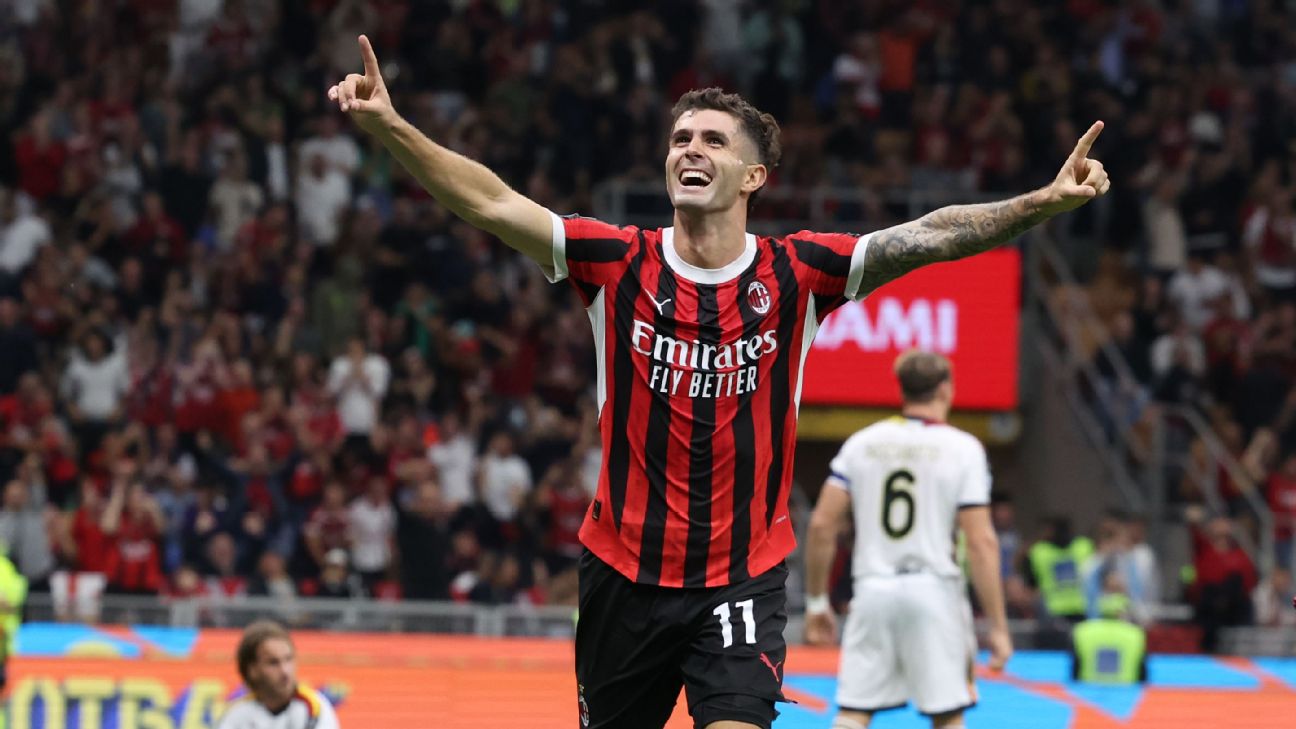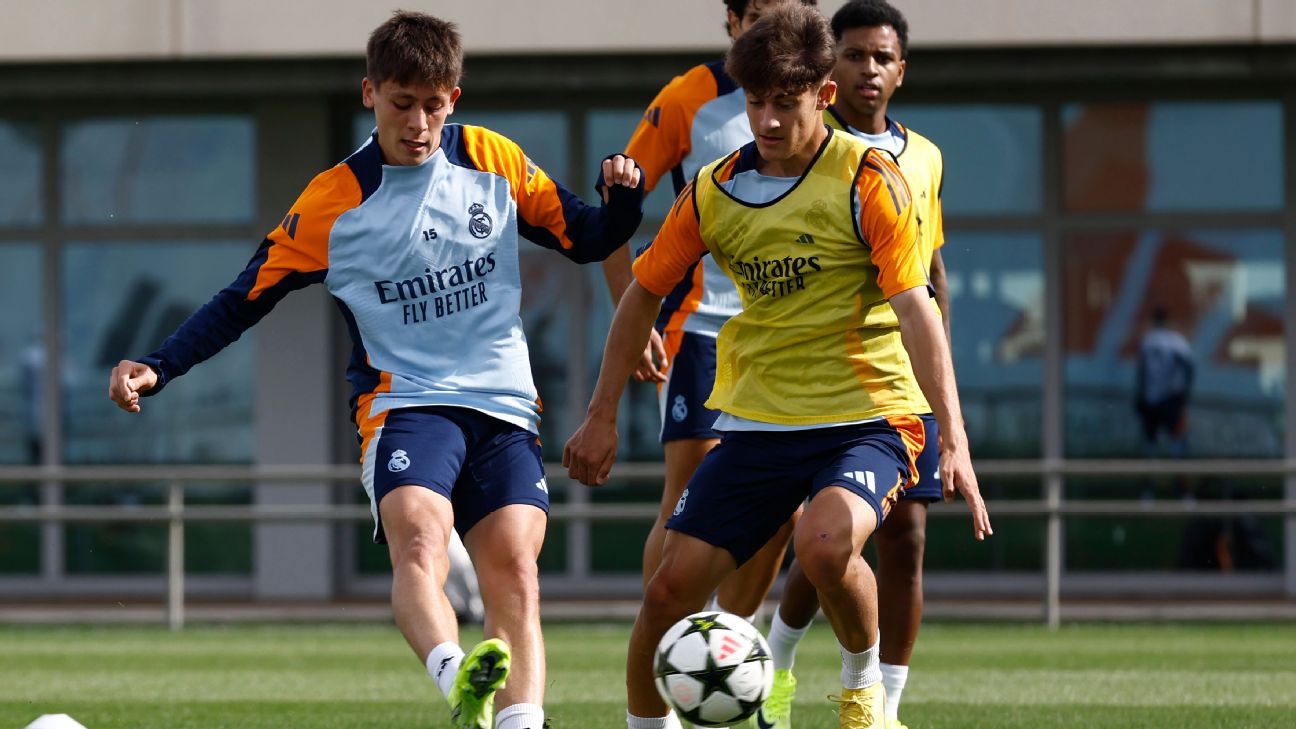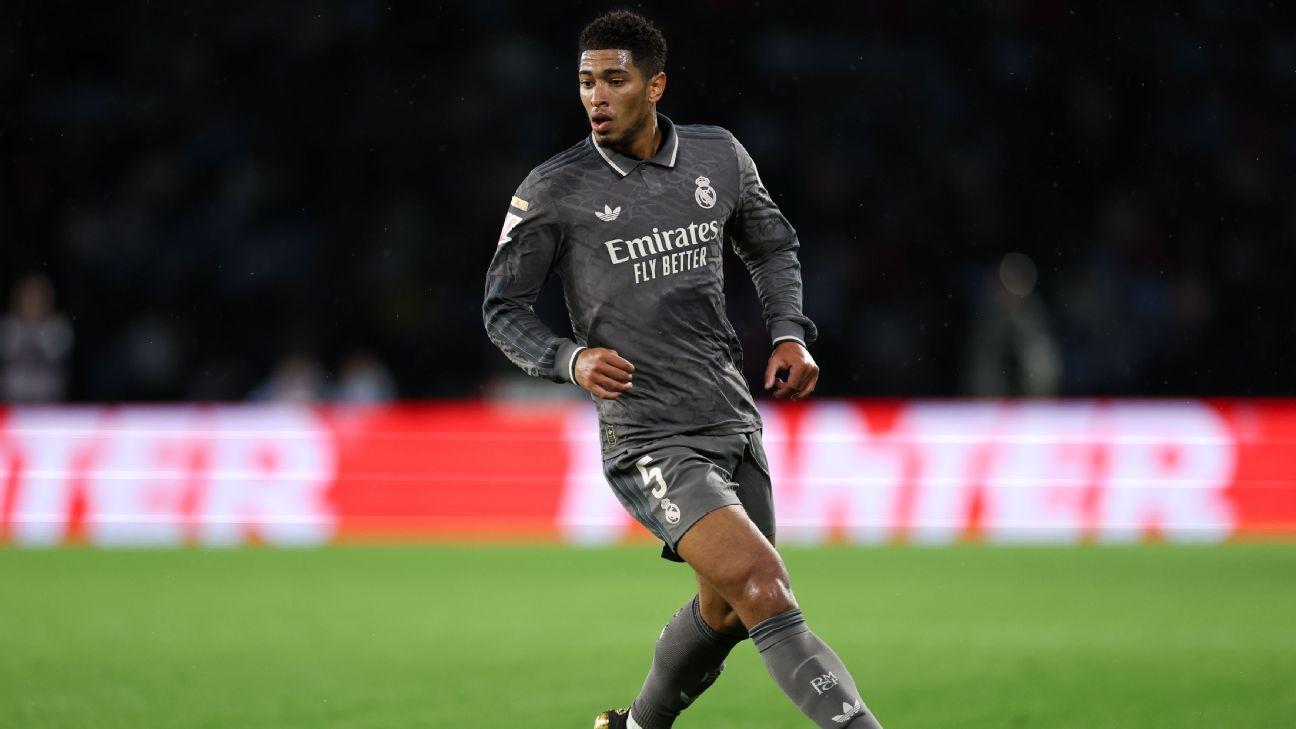Before his first game as U.S. men’s national team manager, Mauricio Pochettino said exactly what you’d expect him to say.
“I think he’s a fantastic player,” he told reporters, “one of the best offensive players in the world.”
He was, of course, talking about Christian Pulisic. The greatest American soccer player alive — the greatest American soccer player of all time. But is he one of the best offensive players in the world?
This was just prepackaged coachspeak, right? Pulisic never locked down a starting spot at Chelsea, and now he’s finally flourishing after taking a step down to AC Milan. We know he’s an above-average attacker, but one of the best?
Of course Pochettino is going to say this about his captain and his most important player. To say anything else would create a mini-controversy, or at least some unfavorable headlines. And to say anything else would suggest that the team he just took over isn’t that good. If your best player isn’t one of the best players in the world, then how can you realistically expect to make a deep run at the World Cup in two years?
But, well, through seven Serie A matches, Pulisic really has been — to quote his new coach — one of the best offensive players in the world. What has changed for Pulisic? And how likely is it to continue?
Why Pochettino wasn’t wrong about Pulisic
The currency for all offensive players is goals and assists. Obviously there’s way more you can do to contribute to your team’s performance other than those two things, but over the long run, the best attackers in the world are going to be the ones that score and create the most goals.
While there was plenty else that Lionel Messi did that didn’t show up in these two simple statistical columns, you don’t really need any of the other stuff to argue that he’s the greatest soccer player to ever live.
Across the site FBref’s entire database for Europe’s Big Five top leagues, Messi leads all players with a career non-penalty goals+assists rate of 1.2 per 90 minutes. Cristiano Ronaldo, the only modern player any person (and many bots) would even try to argue for as better than Messi, averaged 0.9 goals+assists per 90. That’s about an extra goal every third game from having Messi in your team instead of Ronaldo.
I’d like to try to limit the amount of hate mail I get from this piece, so now let’s quickly and inelegantly just move on.
If we apply the same simple analysis to the current season, we have seven players who have been better than Messi. Among all players to play at least 500 minutes across Europe’s Big Five leagues, here’s everyone averaging more goals+assists than Messi did across his entire career, rounded up to the first decimal place:
1) Omar Marmoush, Eintracht Frankfurt: 2.0 non-penalty goals+assists per 90 minutes
2) Cole Palmer, Chelsea: 1.5 goals+assists per 90
3) Harry Kane, Bayern Munich: 1.4 goals+assists per 90
4) Bukayo Saka, Arsenal: 1.4 goals+assists per 90
5) Robert Lewandowski, Barcelona: 1.4 goals+assists per 90
6) Marcus Thuram, Inter Milan: 1.3 goals+assists per 90
7) Erling Haaland, Manchester City: 1.3 goals+assists per 90
And while they’re not better than Messi, there are seven other guys in Europe who are averaging at least 1.0 goals+assists per 90 minutes:
8) Nicolas Jackson, Chelsea: 1.2 goals+assists per 90
9) Lamine Yamal, Barcelona: 1.1 goals+assists per 90
10) Raphinha, Barcelona: 1.1 goals+assists per 90
11) Mohamed Salah, Liverpool: 1.0 goals+assists per 90
12) Ollie Watkins, Aston Villa: 1.0 goals+assists per 90
13) Luis Henrique, Marseille: 1.0 goals+assists per 90
14) Christian Pulisic, AC Milan: 1.0 goals+assists per 90
Now, let’s get pedantic for a second. Pochettino’s quote was vague. There are around 100,000 professional soccer players in the world, according to FIFA. So, if you’re playing in one of Europe’s top leagues as an offensive player, you are, by definition, one of the best offensive players in the world. But let’s get more specific.
Let’s say that there are five teams in any given season that are good enough to win the Champions League, and that Pochettino was suggesting that Pulisic is good enough to start for one of those teams. Pretty much everyone plays with three attackers these days, so there would then be 15 available slots among the “best offensive players in the world.”
And so, yes, in terms of scoring and creating goals across a large-enough sample of minutes, Christian Pulisic has been one of the best offensive players in the world.
Will Pulisic continue to be one of the best offensive players in the world?
In case you need me to spell it out: that list I just showed you probably isn’t going to be perfectly predictive for how the rest of the season goes. If it is, Marmoush will not only be the best Egyptian player in the world, but will have put together the greatest season in the history of the sport. Nicolas Jackson will go from being widely derided for being unable to kick a soccer ball to “as good as Messi.” And Real Madrid will employ none of the best players in the world.
At the same time, most of those names will probably be near the top of the goals+assists leaderboard come season’s end: Harry Kane? Bukayo Saka? Erling Haaland? Robert Lewandowski? Lamine Yamal? Mohamed Salah? These are the best of the best.
So, what might it mean for Pulisic?
“It’s tough to explain,” he said before the Panama game. “I think you have moments in your career where it feels like everything you touch goes in, and you have other times when it feels like you’re trying everything and the ball just won’t go in.”
He’s not quite right. Everything he touches isn’t going in. Every other thing he touches is going in.
Through seven Serie A matches with Milan, Pulisic has attempted 11 shots and he’s scored five goals, one of which was a penalty. Here’s what that all looks like — the bigger the circle, the higher the expected goals, or xG, from a shot like that:
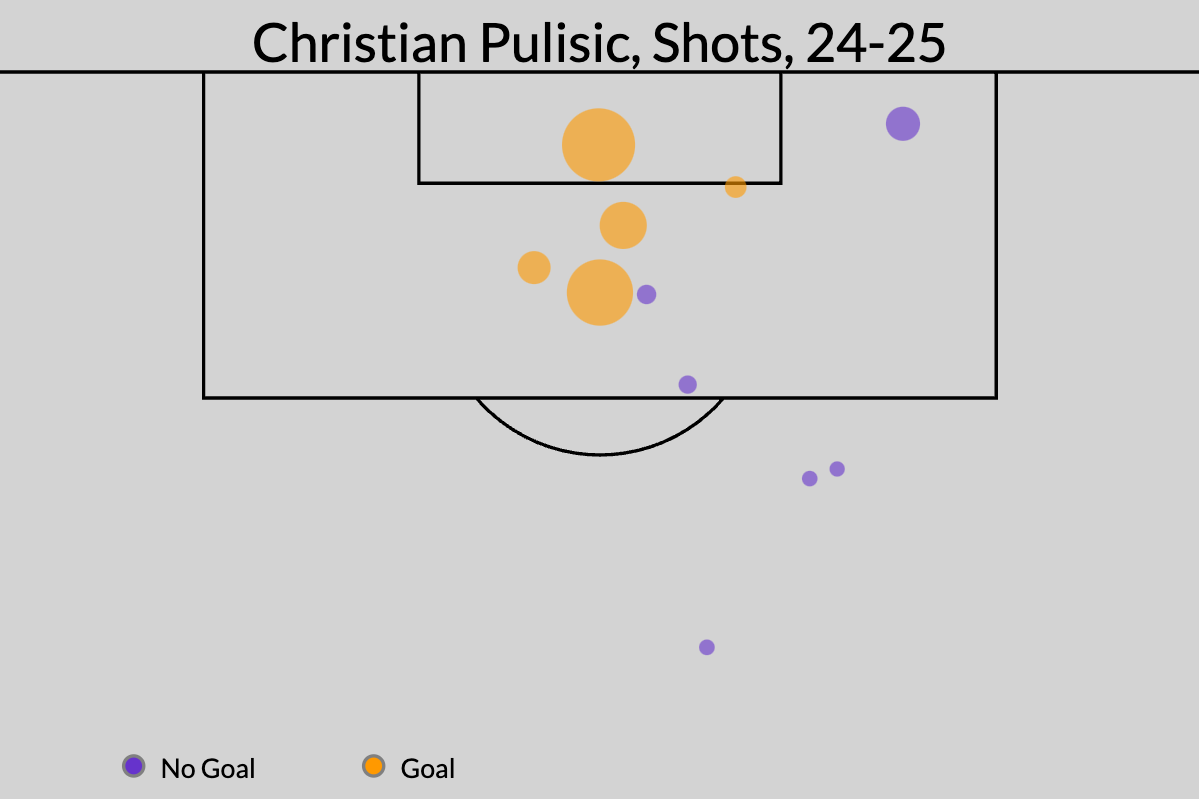
Spoiler: Christian Pulisic is not going to continue scoring with half of the shots he takes. Of the non-penalty variety, his attempts have been worth 2.4 xG, and he’s turned that into four goals.
But there’s been no such unsustainability to his creative production thus far. Pulisic has two assists from exactly two expected goals-assisted. Here’s every chance he’s created this season:
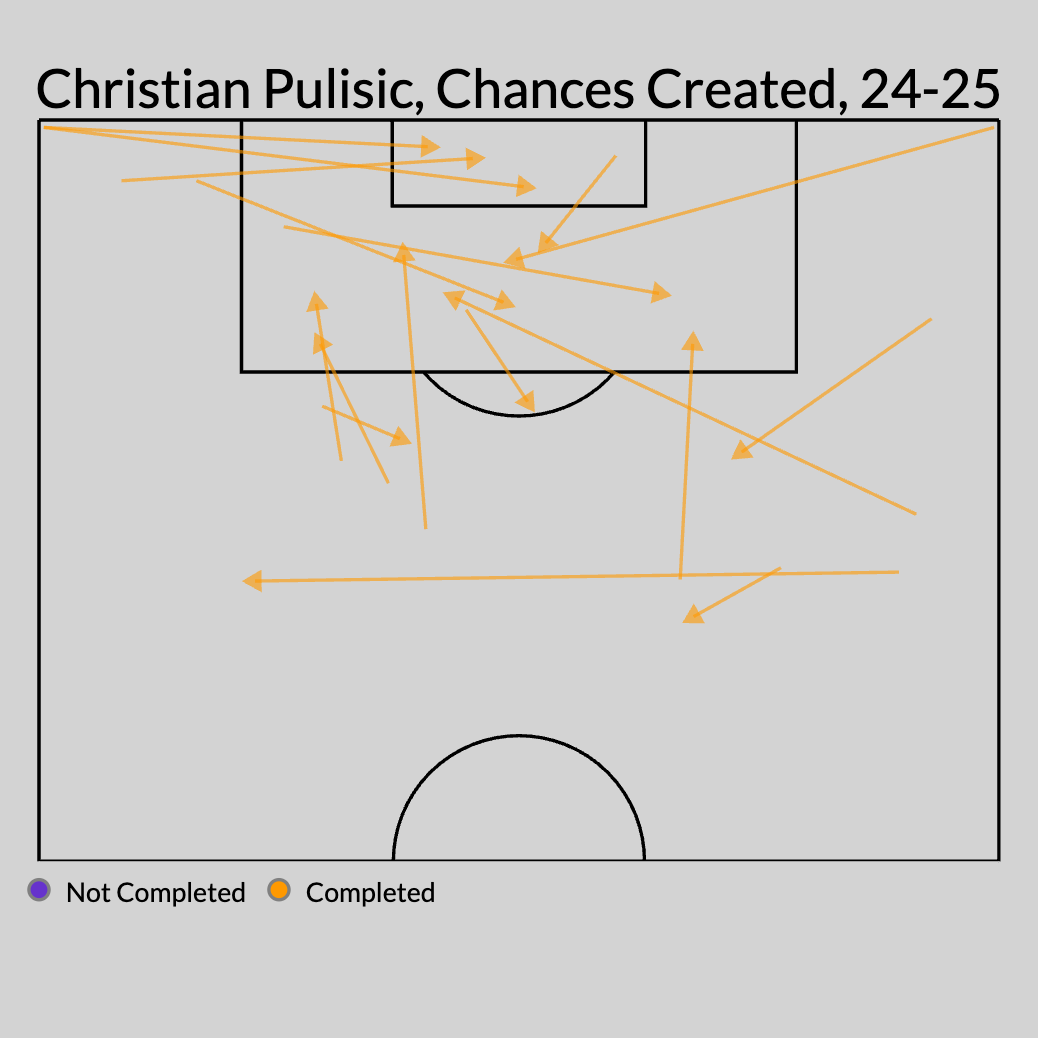
Take it all together, and his production is a good deal above his underlying performance: 1.0 non-penalty goals+assists per 90 minutes, compared to 0.7 expected goals+assists per 90 minutes. Now that might make it seem like the answer is “no, he can’t keep this up” and “no, he’s actually not one of the best offensive players in the world.” But if we use that same 500-minute cut-off point, Pulisic’s expected output ranks exactly the same as his actual output: 14th across Europe’s Big Five leagues.
It would’ve been true last season, too. Across the entire 2023-24 season, Pulisic’s 0.7 npxG+xA from this season would’ve ranked 15th among all players who featured in at least 2,000 minutes. And so, if his finishing comes back to Earth but Pulisic is able to maintain this shot-taking and shot-creating profile for the rest of the season, he will be one of the best offensive players in the world.
But will he be able to do that? The 0.7 number would be a career-best and something he hasn’t even sniffed since his first season with Chelsea in 2019-20, which included that brief Project Restart stretch when he might’ve been the best player in the Premier League. Although looking at all of the shots a player takes and creates — rather than just the ones that get converted into goals — give us a much better sense of how effective that player is and will likely be in the future, there still is plenty of noise in those numbers this early in the season.
Herculez Gomez believes Christian Pulisic is in the best form of his career.
Pulisic is only attempting 1.7 shots per 90 minutes so far. He took 2.3 with Milan last year and averaged 2.5 over his four seasons with Chelsea. That decline in quantity has been canceled out by a rise in quality: 0.24 xG per shot this year, compared to a career average of around 0.14. That’s fine — better even — but it’s rare for an attacker to subsist off that kind of shot diet for a whole season. Of Pulisic’s 2.4 non-penalty xG this season, 37% of it came from one open-goal tap-in against Parma. How many more of those huge chances will he get?
Since 2017-18, two players have played at least 2,000 minutes in a season and generated at least 0.39 xG per 90 while taking 1.7 shots or fewer: Simy for Crotone in 2020-21 and Jean-Philippe Mateta for Crystal Palace last season. Not only is it rare for a player to do what Pulisic is doing for 38 games, we’ve never seen a player in his position do it. Nwankwo and Mateta are both low-touch center-forwards for bottom-half teams that don’t see much of the ball. Milan are in the Champions League and expect to be there again next season.
Now, this isn’t to say that Pulisic couldn’t add more shots going forward — we’ve seen him do it every year of his career. It’s just that something will have to change for him to keep this up.
And a lot has already changed.
How Pulisic became a completely different player
What used to make Pulisic a potential world-class player was his ability to carry the ball into or find space to receive a pass inside the penalty area. Well, guess what? He’s currently averaging a career low in progressive carries, carries into the penalty area, touches inside the penalty area, and progressive passes received.
The last number is the biggest change. Last season under manager Stefano Pioli, Pulisic received 293 progressive passes — the most in Serie A. This season, he’s received just 35 — or half as many as he was receiving per game last season. While he was AC Milan’s primary outlet to move attacks forward last season, his role has been way different in a way different team.
Under Paulo Fonseca, Milan haven’t played much in transition — they’re averaging nearly 10 fewer possessions per game. They’re not pressing anywhere near as aggressively as last season, but they’re also controlling much more of the ball in dangerous areas: 62% of final-third possession, compared with 54% last season. In other words: they want to keep the ball in their attacking third — regardless of who’s in possession of it.
Surprisingly, this has been great for Pulisic, the Dortmund-educated speedster who used to thrive in open-field chaos. While Pulisic is on the ball way less often in the box and taking the fewest shots per game of his career, he’s also creating nearly twice as many chances per game as his career average, and the same goes for his expected-assist production. He’s already completed five through balls, which is more than he’s ever had in a single season. Reminder: it’s mid-October.
Although he’s not touching the ball inside the penalty area as much, he’s way more involved in Zone 14, which is the central area immediately outside of the penalty area. Studies have found that teams that access this area most often are the teams that tend to win most often. Usually, you’d expect players to play the ball to Pulisic from this area. Instead, he’s leading all Serie A attackers with 67 touches inside Zone 14.
Whatever way the rest of the season ends up going, this new style certainly seems more sustainable for a player who reached 2,500 minutes in a season for the first time in his career just last season. With all the high velocity off-ball runs and dangerous carries into traffic, Pulisic has spent an outsized amount of his career on the ground, trying to recover from a foot to the shin or a shoulder to the back.
Over his professional career, Pulisic has been fouled about 1.7 times per game. This season, he’s only been fouled once — in seven games.
Of course, the skeptical view of all this is that Pulisic won’t be able to keep scoring so many goals on so few shots and that he won’t be able to be this productive without getting more touches inside the box. When attackers see their shot totals decline and their touches inside the penalty area decline, it’s usually not a sign that they’re getting better.
But I’m not sure that’s more persuasive than the other side of the argument. Pulisic is putting up career-best production while basically functioning as a top-of-the-box playmaker. Even if he’s not running with the ball at his feet or finding space to receive forward passes and balls into the box, we still know he can do all of that because he did it just last year. He can access that more physical mode of playing if he needs to.
Whether or not Pulisic keeps up his performance, the first few months of the season have at least shown us something new. We knew he could be this good, but we didn’t know he could do it like this.
